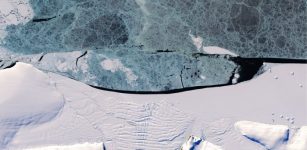Ancient Geologic Structure That Restricts Water Flows Beneath Antarctica’s Ross Ice Shelf
Eddie Gonzales Jr. – MessageToEagle.com – The ROSETTA-Ice team members spent 3 years on data collection survey of Antarctica’s Ross Ice Shelf and discovered an ancient geologic structure that restricts where ocean water flows.
The discovery suggests that local ocean currents may play a critical role in the ice shelf’s future retreat. The massive Ross Ice Shelf helps slow the flow of about 20 percent of Antarctica’s grounded ice into the ocean—equivalent to 38 feet of global sea level rise.
 This giant iceberg, B-15A, broke off the Ross Ice Shelf in Antarctica. (Credt: Josh Landis/NSF)
This giant iceberg, B-15A, broke off the Ross Ice Shelf in Antarctica. (Credt: Josh Landis/NSF)
Using IcePod device mounted on a cargo plane, researchers collected data across the polar region as large as Spain where ice that is frequently more than a thousand feet thick prevents more traditional ship-based surveys of the seabed.
The mapped results revealed significant variations (similar to the heartbeat on a cardiogram) in the middle of the ice shelf. Thus researchers identified a previously unmapped segment of the geologic boundary between East and West Antarctica.
“We could see that the geological boundary was making the seafloor on the East Antarctic side much deeper than the West, and that affects the way the ocean water circulates under the ice shelf,” lead author Kirsty Tinto, a Columbia University’s Lamont-Doherty Earth Observatory researcher, said in a press release.
Compared with the Amundsen Sea to the east, where warm water crosses the continental shelf to cause rapid melting of the ice shelves, little warm water reaches the Ross Ice Shelf.
In the Ross Sea heat from the deep ocean is removed by the cold winter atmosphere in a region of open water, called the Ross Shelf Polynya, before flowing under the ice shelf. This cold water melts deeper portions of east Antarctic glaciers, but it is steered away from the west Antarctic side by the depth change at the ancient tectonic boundary.
“We found that the ice loss from the Ross Ice Shelf and flow of the adjoining grounded ice are sensitive to changes in processes along the ice front, such as increased summer warming if sea ice or clouds decrease,” said Laurie Padman, a co-author and senior scientist at Earth and Space Research.
Written by Eddie Gonzales Jr. – MessageToEagle.com Staff Writer










